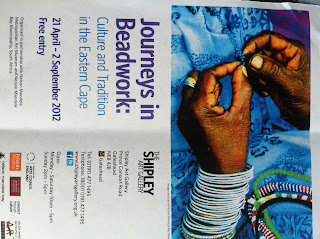Journeys
in beadwork: contemporary and tradition in the Eastern Cape explores the history
of beadwork of the Mfengu tribe in South Africa and beadwork in contemporary
fashion.
In
the culture and tradition in the Eastern Cape part of the exhibition, it
celebrates the beadwork of 19th century South Africa and how it has
became an integral part of their life. The beadwork in this part of the world
is very diverse, inventive, delicate and handmade and features a lot of blue,
red, green, white, yellow and orange tones being used as decoration on black
and white clothing.
The
beadwork is very extravagant and mainly used on head scarves and aprons,
showing solidarity to ones community. They incorporate their own style into the
beadwork and no two collars were ever made the same. Jewellery embellishment
was also a big part of their lifestyle as beads were given to boys that teenage
girls were attracted to, showing a sign of affection to them. With this, the
beadwork had to be returned if the relationship broke down. Beautiful beaded ties
were worn on special occasions and became popular in the 1980’s with the same
African beadwork. The beads that were commonly used were nacre and seed beads
which were sewn onto black cotton to create the intrinsic, bold patterns. Marriage
wear consisted heavily of extravagant beadwork which featured over 70 pieces on
one gown and candles or paraffin lamps were often used to light the intricate
work. Long strands of beads called ‘isidanga’ would hang to the knees as part
of a dance celebration in the African culture and now elements are being
integrated into fashion which are made by Nelson Mandela’s bay beadwork group.
In
the contemporary part of the exhibition, it features designers work such as
YSL, John Galliano and John Paul Gaultier who are inspired by traditional
clothing, patterns and designs from Africa. In this part of the exhibition, it
shows how the patterns and colours have been taken from the African culture and
recreated into modern pieces of work. Patricia Mbela from Africa’s fashion work
is shown who was inspired by her childhood experience of a journey she took.
Her collection consisted of blues and whites of the mountains and yellows and
oranges of the African sunlight. Her embellishment features very heavily on the
long strands of beads overlapped on the white cotton to create that similar
effect used by the Africans. Again, modern handmade jewellery has been created
by Fabienne Morel of Switzerland, who took inspiration from club culture and
urban landscapes mixed with the traditional African beadwork. Her work features
the same colourings and diagonal line patterns used in 19th century
Africa. Buki Akib of London, also featured his fashion collection at the
exhibition who was inspired by Nigerian music and the afrobeat movement. His
work is very bold and extravagant and features a heavy multi coloured jacket
with flamboyant tassels bunched together at the shoulders to create a very
dramatic effect. Gold and purple hues were featured alongside geometric
patterns and trousers which mirrored the same shape of the African yemba beaded
apron creating a very bold statement, showing where he has gained his
inspiration from. Lisa Folawiyo of Nigeria was yet another one to show her
fashion collection and her embellished Ankara textiles. The fabrics she used
were West African and dyed with beads, sequins and crystals embellished on
which took 120-240 hours to make. Her spring/summer 2012 collection was
inspired by Nigerian photographer Okhai Ojeikere who created 1960’s portraits
where she revisited the past and reinterpreted traditional fabrics into modern
female silhouettes. Her embellishment is extremely intrinsic and stunning and she
has cleverly recreated the same patterns of Africa in her simple yet effective,
diagonal beadwork.
Overall,
I really got the feel of the hours and effort that was put into the African
beadwork in the 19th century and how it can be took to recreate some
beautiful, modern fashion garments.











No comments:
Post a Comment